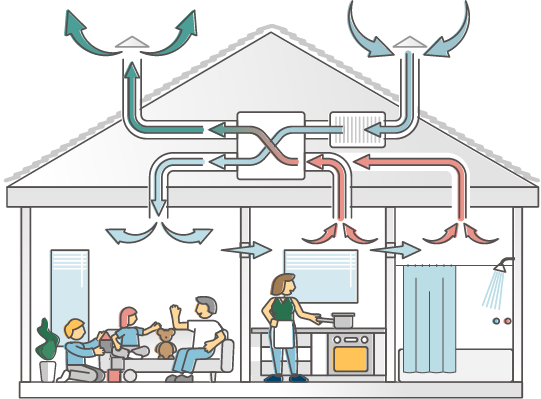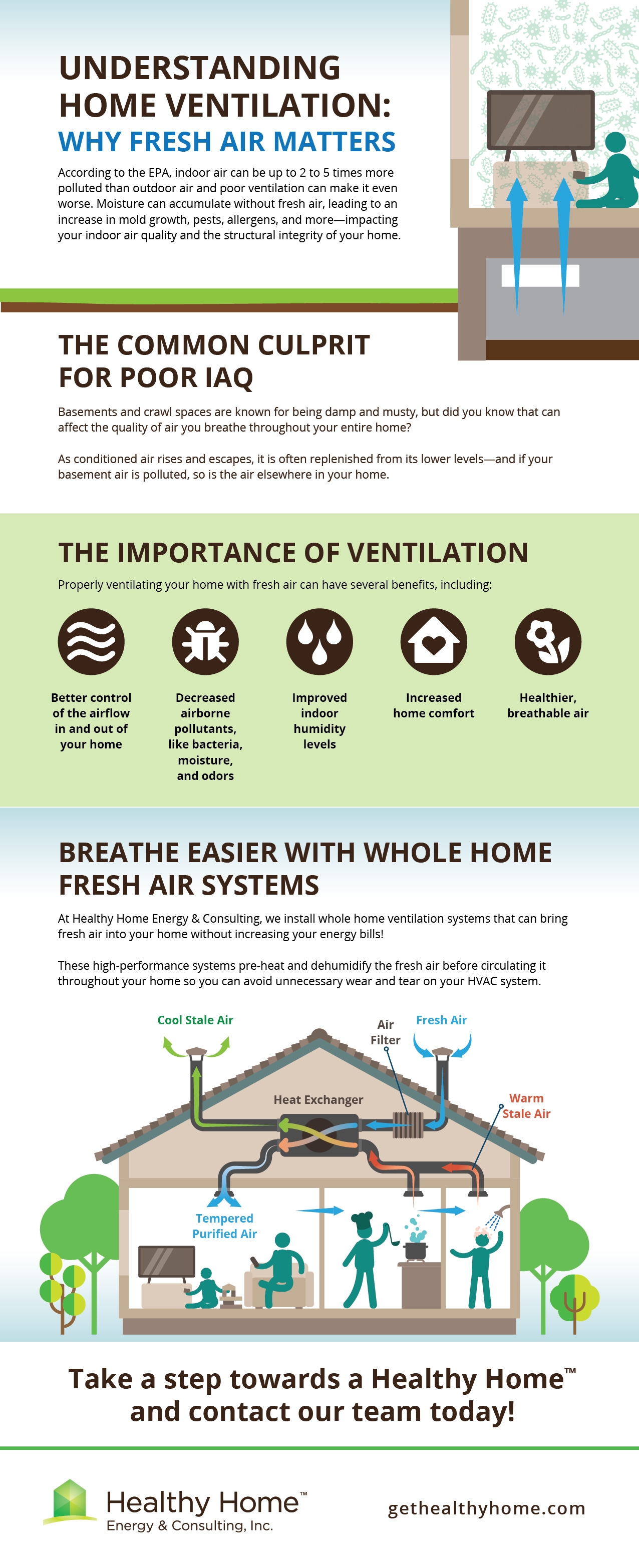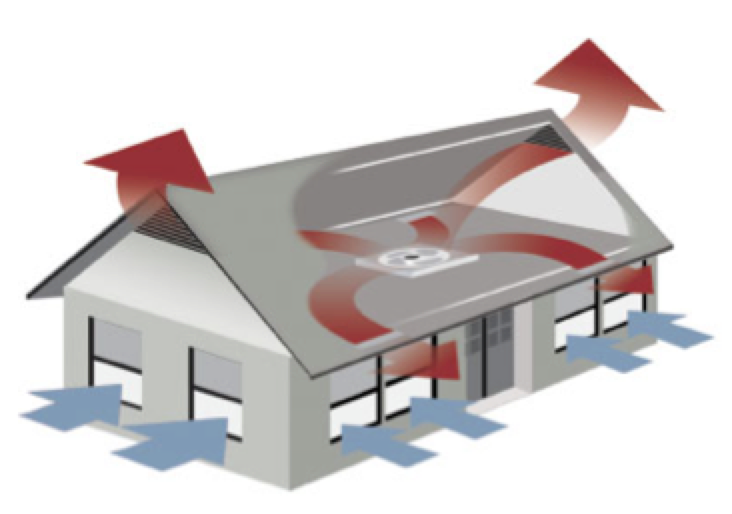Comprehending the Value of Home Ventilation for a Healthier Living Setting
Home ventilation plays an important duty in preserving a healthy living atmosphere. It helps with the exchange of outside and interior air, which is very important for boosting air quality. Without proper air flow, homes can become breeding premises for toxins and irritants. The effects of inadequate air flow can be considerable. This brings up the inquiry of exactly how house owners can successfully carry out ventilation approaches to protect their health and well-being. Recognizing these approaches is important.

The Fundamentals of Home Ventilation
Home ventilation functions as a necessary element of indoor air high quality and convenience. It involves the process of trading stale interior air with fresh outdoor air, thus reducing humidity and managing temperature level. Appropriate ventilation systems can consist of natural methods, such as open home windows and vents, along with mechanical systems, such as exhaust followers and air exchangers. Effective home ventilation helps avoid problems like indoor mold and mildew development and the buildup of unsafe bits. It likewise enhances total energy performance, as well-ventilated spaces can preserve comfortable temperatures with less dependence on home heating and cooling down systems. Comprehending the basics of home air flow is crucial for homeowners seeking to develop a healthier living environment on their own and their family members.

Typical Resources of Indoor Air Contamination

Although numerous may not recognize it, indoor air pollution can stem from numerous sources within a home. Typical contributors consist of unstable organic compounds (VOCs) sent out from paints, solvents, and cleaning items. Household appliances, such as gas ovens and fireplaces, can launch damaging gases like carbon monoxide and nitrogen dioxide. Furthermore, mold and mildew and mildew thrive in moist locations, launching spores that affect air high quality. Animal dander, dust mites, and pollen can gather inside, further exacerbating pollution degrees. Smoking cigarettes inside your home generates hazardous chemicals that stick around airborne. Constructing products, consisting of asbestos and formaldehyde, can off-gas damaging compounds. Acknowledging these resources is vital for preserving a healthier indoor environment and promoting reliable air flow approaches.
Health And Wellness Effects of Poor Ventilation
Interior air pollution can have substantial wellness implications, particularly when ventilation is poor. Poor air flow can lead to the buildup of harmful contaminants, such as unstable organic substances, mold and mildew, and particulate matter. This build-up may result in respiratory concerns, consisting of asthma, allergic reactions, and chronic obstructive pulmonary condition. People might experience signs like frustrations, fatigue, and inflammation of the eyes, nose, and throat. Vulnerable populaces, such as kids and the senior, go to higher risk for extreme wellness effects. Long-lasting direct exposure to inadequately ventilated atmospheres can also add to a lot more significant problems, consisting of heart diseases. Ensuring correct ventilation is vital for keeping a healthy living setting and decreasing the threat of health problems associated with indoor air pollution.
Effective Ventilation Strategies for Your Home
Proper ventilation is vital for maintaining a healthy interior atmosphere, and applying reliable techniques can significantly improve air quality. House owners can start by making sure that exhaust fans are mounted in cooking areas and shower rooms to remove excess wetness and odors. Opening windows on a regular basis allows fresh air to distribute, particularly throughout mild weather condition. In addition, using air purifiers with HEPA filters can aid capture airborne toxins. For homes with home heating and cooling systems, maintaining cooling and heating systems and changing filters consistently is essential for peak efficiency. Incorporating all-natural air flow techniques, such as cross-ventilation, can additionally boost air flow. Sealing any kind of leakages in doors and windows avoids unwanted drafts, which can interrupt regulated air flow, eventually leading to boosted indoor air high quality and comfort.
Preserving Ideal Air Top Quality Year-Round
To maintain optimal air high quality year-round, property owners have to take on a proactive method to managing their indoor environment. Frequently keeping track of interior air quality is crucial; this includes checking for toxins such as dust, mold and mildew, and volatile organic compounds (VOCs) Implementing efficient air flow systems, such as exhaust fans and air purifiers, can considerably lower air-borne pollutants. Additionally, routine upkeep of a/c systems warranties peak efficiency and air blood circulation. Homeowners must additionally think about humidity degrees, as excessive moisture can cause mold and mildew development. Seasonal adjustments might demand changes in ventilation approaches to suit differing outside air top quality. By prioritizing these methods, property owners can produce a healthier living space, promoting general health for all owners throughout the year.
Frequently Asked Inquiries
Exactly How Can I Tell if My Home Needs Much Better Ventilation?
To establish if a home requires much better ventilation, one should observe indications such as relentless humidity, mold development, mildewy odors, condensation on windows, or boosted allergic reaction signs and symptoms, indicating poor air flow and possibly bad indoor air top quality.
What Are the Indications of Poor Indoor Air Top Quality?

Can Houseplants Improve Indoor Air High Quality Properly?
The effectiveness of houseplants in improving interior air quality is debated. While some researches recommend they article source can soak up toxic substances and generate oxygen, their overall effect might be minimal contrasted to appropriate air flow and air purification systems.
How Typically Should I Modification My Air Filters?
The regularity of air filter modifications typically depends upon usage and filter kind. Usually, it is advised to change filters every 3 months, though homes with pets or allergic reactions might need more regular adjustments for excellent performance.
Are There Any Type Of Certain Air Flow Solutions for Allergy Sufferers?
Numerous air flow systems, such as HEPA-filtered devices, properly decrease allergens in the air. Home Ventilation Melbourne. These systems trap family pet, pollen, and dirt dander, providing allergic reaction sufferers with a cleaner, healthier indoor setting while taking care of air top quality efficiently
It promotes the exchange of interior and outside air, which is crucial for enhancing air quality. Home air flow serves as a crucial component of interior air high quality and comfort. It entails the process of trading stagnant interior air with fresh outside air, therefore reducing moisture and controlling temperature level. Interior air contamination can have considerable wellness effects, especially when air flow is poor. Proper check that air flow is essential for preserving a healthy and balanced interior setting, and applying efficient strategies can significantly improve air high quality.